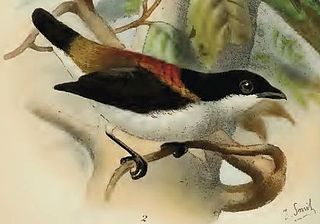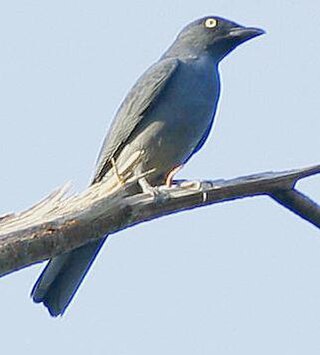
Bubalus is a genus of Asiatic bovines that was proposed by Charles Hamilton Smith in 1827. Bubalus and Syncerus form the subtribe Bubalina, the true buffaloes.

Brachymeles is a genus of skinks. The majority of the species within the genus are endemic to certain island ecosystems in the Philippines. In 2018, the Zoological Society of London through its EDGE of Existence Program listed the Cebu small worm skink as the 80th most evolutionarily distinct and globally endangered reptile species in the world, making it the most endangered member of the genus Brachymeles.

The coppersmith barbet, also called crimson-breasted barbet and coppersmith, is an Asian barbet with crimson forehead and throat, known for its metronomic call that sounds similar to a coppersmith striking metal with a hammer. It is a resident bird in the Indian subcontinent and parts of Southeast Asia. It carves out holes inside a tree to build its nest. It is predominantly frugivorous, but has been observed eating insects, especially winged termites.

The white-bellied woodpecker or great black woodpecker is a woodpecker species inhabiting evergreen forests in tropical Indian subcontinent and Southeast Asia. It is among the largest of the Asiatic woodpeckers and nests in large dead trees, often beside rivers. It has 14 subspecies, and many of its island forms are endangered, some are extinct. Populations differ in the distribution and extent of white. Its drums and calls are louder than those of the smaller woodpeckers.

White-fronted capuchin can refer to any of a number of species of gracile capuchin monkey which used to be considered as the single species Cebus albifrons. White-fronted capuchins are found in seven different countries in South America: Bolivia, Brazil, Colombia, Venezuela, Ecuador, Peru, and Trinidad and Tobago.

The wedge-capped capuchin or Guianan weeper capuchin is a capuchin monkey from South America. It is found in northern Brazil, Guyana and Venezuela. Cebus olivaceus is known to dwell in tall, primary forest and travel over long distances during the day.
The Cebu tamaraw is a fossil dwarf buffalo discovered in the Philippines, and first described in 2006.

The Cebu flowerpecker is a small passerine bird. It is endemic to Cebu Island in the Philippines. Feared to have become extinct early in the 20th century, it was rediscovered in 1992 in a small patch of limestone forest in the Central Cebu Protected Landscape. It has since been found at three other sites, namely the Nug-as forest of Alcoy, Mount Lantoy of Argao and the forests of Dalaguete. This four-colored bird normally grows to 11 or 12 centimeters. The male is characterized by a large, triangular, scarlet to vermilion coat stain. In the female, the top is brown. The Cebu flowerpecker consumes small fruits and mistletoe plants and is generally active in the mornings to avoid competition with more aggressive birds. Despite attempts to protect its habitat it remains critically endangered due to illegal logging.
The lemon-throated leaf warbler is a species of Old World warbler in the family Phylloscopidae.

The Black shama is a species of bird in the family Muscicapidae. It is endemic to the island of Cebu, Philippines where it is known locally as "Siloy".

The bar-bellied cuckooshrike is a species of bird in the family Campephagidae. It is found in Thailand, Malaysia, Indonesia, and the Philippines, and its natural habitats include mangrove forest, dry forest, swamp forest, and secondary forest. The plumage varies among the subspecies, with different amounts of barring on the underparts. The International Union for Conservation of Nature (IUCN) has assessed the species as one of least-concern.
Sicyopus auxilimentus is a species of goby endemic to the Philippines where it is only known to occur in Lagu Lagu Creek on Leyte Island. This species can reach a length of 2.9 centimetres (1.1 in) SL.

Sicyopus is a genus of small gobies. Most are native to fast-flowing streams and rivers in Southeast Asia and Melanesia, but S. zosterophorus also occurs in China, Japan and Palau, S. nigriradiatus is restricted to Pohnpei, S. jonklaasi is restricted to Sri Lanka, and S. lord is restricted to Madagascar.
Sicyopus jonklaasi, the lipstick goby, is a species of goby endemic to Sri Lanka where they occur in rocky hill streams of swift-flowing water. They having sucking discs on their undersides with which they adhere to the sides of rocks. Newly hatched larvae are washed to the sea by heavy flows brought on by rains and mature there before returning to the streams. This species can reach a length of 4.5 centimetres (1.8 in) TL. It can also be found in the aquarium trade.
Buhisan Dam is a dam located in Buhisan, Cebu City, Philippines. It is one of the main source of water for Cebu City and Metro Cebu. Part of Central Cebu Protected Landscape, Buhisan Dam is situated in the mountains of Barangay Buhisan behind Labangon, Cebu. Built in 1911-1912 and maintained by the Metro Cebu Water District, it is being developed into an eco-tourism location. It supplies five percent of Metropolitan Cebu Water District's (MCWD) current water capacity.

Paruparo cebuensis is a species of butterfly in the family Lycaenidae. It is found in the Philippines.
Lepeostegeres cebuensis is a species of mistletoe recently described which is found on Cebu Island, Philippines. Currently this is treated as an unplaced name by Plants of the world online.

Humboldt's white-fronted capuchin is a species of gracile capuchin monkey. It is found in Colombia, Venezuela, Brazil, and potentially the island of Trinidad.
Rabor's short-legged skink is a species of skink endemic to the Philippines.












